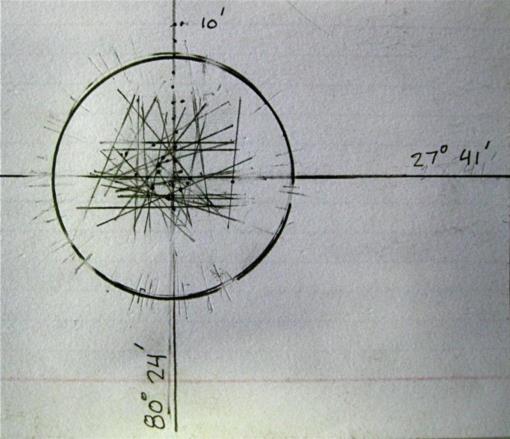
NavList:
A Community Devoted to the Preservation and Practice of Celestial Navigation and Other Methods of Traditional Wayfinding
From: Greg Rudzinski
Date: 2012 Mar 15, 08:14 -0700
Alex,
I found in the archives one of your posts on bubble octant trials with a MK IXa (NavList 2170). If this bubble octant is radium free then I wouldn't worry about using it on a commercial flight here in the U.S.. It would probably be easier to carry in a padded camera bag than the original box.
Your trial results are pretty good. On land anything better than 4 NM from GPS is good and in the air (with averager) anything better than 8 NM is good. See the linked img 1112 for my latest clutch of LOP's taken from a stable platform (no averager). All are better than 5 NM from GPS with a fairly uniform distribution around the GPS position of observation.
Greg Rudzinski
P.S. Aircraft bubble octants won't work on small boats even if using an averager. If equipped with a natural horizon then it will work as a conventional marine sextant (bubble not used as horizon).
[NavList 2170] Bubble sextant trials
From: Alexandre Eremenko
Date: 14 Feb 2007 09:19
Today I made my first observations with my new MkIXa
bubble sextant (purchased on E-bay for $41).
Position 40d27'.2N, 86d55'.8W Sun altitude, refraction -1.5
1. Without the clockwork averager:
GMT: Reading: Error:
16:30:40 32d30' -1.0
16:32:05 32d38' 0.0
16:33:00 32d42'.5 -0.1
16:34:05 32d49' 1.0
16:34:50 32d52' 0.3
16:35:32 32d54.5 -0.7
16:36:30 32d58.5 -1.3
Average error = -0'.26, sigma=0'.8
2. Now with the clockwork averager:
Time at the end of observation: 16:39:10, reading: 22d08'.5.
Assuming the average GMT=16:38:10 I obtain the error of 0'.7.
Remarks. The manual says to time the beginning and the end
of an observation. However I do not see how to time the
beginning with sufficient precision: one needs time to record it,
then to align the images before you trig the clockwork.
Instead, I measured the time that clockwork works: it is 1m57sec,
so in my observations I time the end and then subtract one minute
to get the average GMT of the observation.
Further remarks. The averager seems useless for observations from
a stable platform. Besides, it is very heavy, and my hands get tired
in the two minutes needed for an observation. So Ken's idea to cut
the averager off seems reasonable for backyard observations.
I wonder if the averager will help on a small boat.
I noticed that something strange happens with the bubble:
as I observe, small bubbles come from 10 oclock direction and
join my main bubble. So it grows:-)
Do I have to rotate the bubble wheel anticlockwise (relaxing the
tension
of the membrane) after the size of the bubble is adjusted?
The observation I posted above was my 3-d trial. In the first two I
was
lerning how to keep the bubble and the Sun in a good position, how
to read the scale and what is the right size of the bubble.
It seems that smaller bubble gives better results.
Will try some stars if weather permits.
Alex.
----------------------------------------------------------------
NavList message boards and member settings: www.fer3.com/NavList
Members may optionally receive posts by email.
To cancel email delivery, send a message to NoMail[at]fer3.com
----------------------------------------------------------------







